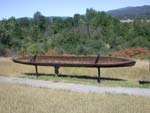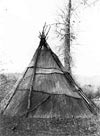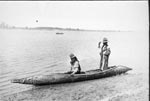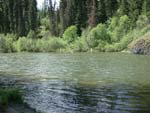 | | Dugout Canoe |
Schitsu’umsh
have successfully traveled their richly endowed landscape, with Coeur d'Alene Lake at its center, "since time immemorial." "Success" was based upon the ability of the Schitsu’umsh to indeed "travel" and to apply the tremendous knowledge of the animals and plants and of the changing seasons as established by the First Peoples. To remain in one location year round would have only assured certain hunger. There was an intricate network of overland trails and waterways that allowed Schitsu’umsh families ease of access to the widely dispersed berry patches, camas fields, hunting areas, and fishing spots. With the bark from birch, cedar and their unique use of white pine, framed-canoes were readily made to travel the rivers and lakes. Pine and cedar dugout canoes were also made. Both the common style canoe, with prow and stern curved up, and the "bull-nosed" (sometimes referrd to as, "sturgeon-nosed") canoe, with prow and stern curved down, were used. And with the tule reeds that grew from the lake's shore, seasonally-adapted lodges were constructed. The reeds were made into roll-up mats that could be readily transported. Using either a tipi-like or longhouse frame, the tule mats were layered onto the poles, providing cool habitats during the hot summers and warmth during the winter. With the coming of rain or snow, the individual tules would expand, creating a watertight surface. After the horse had become part of the Schitsu’umsh family in the late 18th century, travel over these land routes became easier, as was travel to distant fishing and trading centers, such as Kettle Falls.
|
|
The place to begin an understanding of what it means to be Schitsu'umsh is with the Lake. Listen as Cliff SiJohn discusses the importance of the Lake Coeur d'Alene and water for the Schitsu'umsh, the "blood in our veins." Also discussed is the use of canoes to travel the water ways. Part 1 of Interview. (interviewed and edited by Rodney Frey, August 2002)
|
 | | Tule-mat lodge. ca. 1907 |
But knowledge of canoe and lodge building were only two necessary skills needed to travel the landscape. To successfully fish, hunt and gather the "gifts" of the landscape family members needed to know the detailed habits of the deer, trout, camas and huckleberries as each interacted with the changing seasons. Given the weather conditions at the moment, families had to know with precise accuracy when the gifts would be ready and where they would be located. Moving an entire camp of many extended families on a several day’s journey had to be rewarded with success at trail’s end.
It was thus a comprehensive and in-depth knowledge base upon which the Schitsu’umsh relied. With it they deliberately and successfully traveled a well-established and seasonally-selected pattern of movement through their landscape; it was anything but nomadic and random. Traditionally, there were five generally recognized seasons, Syihih - early spring, Setqaps - mid-spring, Yalstq - summer, Sch'edp - fall, and Sit.sitkw - winter.
|
|
Listen as Cliff SiJohn continues discussing the importance of the lake and talks about an important "fish camp" near Tekoa where salmon were caught as they came up the Little Hangman Creek. It was a land of "abundance and the people flourished." Part 2 of Interview; To continue the SiJohn Interview. |
Today, many Schitsu'umsh families continue to rely upon the deer and salmon as their primary source of meat. Many families still dig the camas during the summer and gather the berries in the fall, if for nothing more than to continue what the grandmothers once did and for that special occasion when those grandmothers may want a little of the roots and berries for a birthday celebration. While the seasonal round has been supplemented, though not replaced, by nine-to-five jobs, the spiritual and cultural value it holds for the Schitsu'umsh remains alive.
© Coeur d'Alene Tribe 2002
< previous |
next >
|












